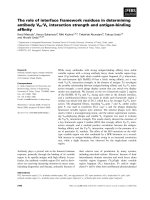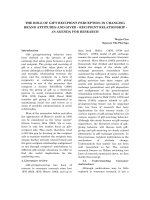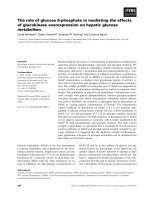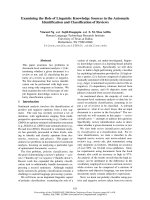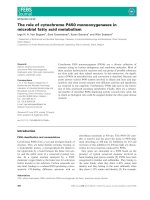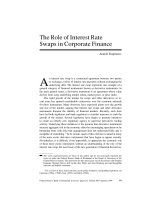The role of cyclops nodal signaling in zebrafish early embryogenesis
Bạn đang xem bản rút gọn của tài liệu. Xem và tải ngay bản đầy đủ của tài liệu tại đây (20.08 MB, 243 trang )
THE ROLE OF CYCLOPS/NODAL SIGNALING
IN ZEBRAFISH EARLY EMBRYOGENESIS
TIAN JING
TEMASEK LIFE SCIENCES LABORATORY
NATIONAL UNIVERSITY OF SINGAPORE
2006
THE ROLE OF CYCLOPS/NODAL SIGNALING
IN ZEBRAFISH EARLY EMBRYOGENESIS
TIAN JING
(M.Sc.)
Wuhan Institute of Virology
Chinese Academy of Science
A THESIS SUBMITTED
FOR THE DEGREE OF DOCTOR OF PHILOSOPHY
TEMASEK LIFE SCIENCES LABORATORY
DEPARTMENT OF BIOLOGICAL SCIENCES
NATIONAL UNIVERSITY OF SINGAPORE
2006
ACKNOWLEDGEMENTS
I would like to express my greatest gratitude to my supervisor Dr. Karuna Sampath
for giving me the opportunity to pursue my Ph.D. research work in her laboratory. I
deeply appreciate Dr. Sampath for her excellent supervision, encouragement, patience
and unfailing support throughout the course of this work, and for her invaluable
amendments to this thesis. My sincere thanks also go to the members of my graduate
supervisory committee, A/P Vladimir Korzh, Dr. Jiang Yunjin and Dr. Sudipto Roy
for their constructive comments and encouragement during the course of this work.
I would like to thank the past and present members in KS laboratory: Aniket Gore,
Srinivas Ramasamy, Gayathri Balasundaram, Wang Hui, Tang Lan, Tao Shijie,
Albert, Helen, Jiao Binwei, for their kind concern, helpful discussion, technical
assistance, cooperation, and friendship. Many thanks also go to my attachment
students: Caleb Yam, Tin Lay, Yaoquan, Chan Aye Thu and Wang xin. I thank Dr.
Gilligan Patrick Clemente, Dr. Ajay Sriram and Mr. Albert Cheong Shea Wei, Ms.
Lim Shi Min and Ms. Phua Sze Lynn Calista for their critical reading of my thesis.
I thank the fish facility and sequencing facility of TLL for the great service they
provided, such that my project was able to proceed smoothly.
My heartfelt and deepest appreciation goes to my husband, Zhang Dongwei, for his
love, patience, understanding, and support over these years. I also would like to thank
my beloved daughter Esther, for the joy and happiness she brings me. Last, but
certainly not the least, this thesis is dedicated to my parents, for their unwavering
support, encouragement and belief in me always.
Tian Jing
March, 2006
Table of Contents
ii
TABLE OF CONTENTS
ACKNOWLEDGEMENTS i
TABLE OF CONTENTS ii
LIST OF FIGURES
ix
LIST OF TABLES xii
LIST OF ABREVIATIONS xiii
LIST OF PUBLICATIONS xviii
CONTRIBUTION TO THIS THESIS xviii
SUMMARY xix
CHAPTER I INTRODUCTION 1
1.1 TRANSFORMING GROWTH FACTOR β SIGNALING
PATHWAY: A CRITICAL SIGNALING PATHWAY
IN DEVELOPMENT 2
1.1.1 TGFβ Superfamily: One of the Largest Families of Secreted
Multifunctional Peptides
2
1.1.2 Regulation of TGFβ Signaling Pathway 6
1.1.2.1 Controlling secretion and activation of TGFβ ligand 6
1.1.2.2 Regulation of receptor activation 9
1.1.2.3 Smads – TGFβ signaling transducers 11
1.1.2.4 DNA – binding partners in nucleus 13
1.1.3 Role of Transforming Growth Factor β Signaling Pathway
in Cancer and Developmental Disorders 14
1.2 ZEBRAFISH AS A MODEL ORGANISM FOR
VERTEBRATE DEVELOPMENT 16
1.3 NODAL/ TGFΒ SIGNALING PATHWAY IS INVOLVED
IN PATTERNING ZEBRAFISH EMBRYOS 18
Table of Contents
iii
1.3.1 The Nodal Signaling Pathway in Zebrafish Embryos 18
1.3.1.1 Nodal ligands 19
1.3.1.2 Receptors and coreceptors 22
1.3.1.3 Extracellular inhibitors 24
1.3.1.4 Transcriptional regulators 25
1.3.2 Roles of Nodal Signaling Pathway in Patterning of Zebrafish Embryos 26
1.3.2.1 Mesoderm and endoderm specification 26
1.3.2.1.1 Nodals can act as morphogens 28
1.3.2.1.2 Different levels of Nodal signaling induces different
cell types 29
1.3.2.1.3 Feedback regulation in mesoderm induction 30
1.3.2.2 Left-right axis formation 33
1.3.2.3 Neural patterning 34
1.4 INDUCTION AND FUNCTION OF THE FLOOR PLATE 35
1.4.1 The Floor Plate – A Transient Structure in the Central Nervous
System Which Forms During Neurulation 35
1.4.2 The Functions of The Floor Plate are Mediated by Shh 36
1.4.3 The Origin of the Floor Plate 40
1.4.3.1 Model one: Shh-mediated induction of floor plate
by notochord 41
1.4.3.2 Model two: floor plate formation occurs independent
of the notochord 46
1.4.3.2.1 Node/organizer: the common source of floor plate
and notochord precursor 46
1.4.3.2.2 Where the floor plate cells are induced: functional
domains within Hensen’s node 50
1.4.3.2.3 The different origins of medial floor plate (MFP)
Table of Contents
iv
and lateral floor plate (LFP) 50
1.5 RESEARCH OBJECTIVES 54
1.5.1 The Role of Cyclops/Nodal in Floor Plate Induction 54
1.5.2 The Molecular Mechanism of Cyclops/Nodal in Zebrafish Development 55
CHAPTER II MATERIALS AND METHODS 57
2.1 ZEBRAFISH STRAINS AND MAINTENANCE 58
2.1.1 Fish Maintenance and Embryos Culture 58
2.1.2 Fish Strains Used For the Studies 58
2.2 CYC ALLELE SCREEN, MAPPING AND SEQUENCING 58
2.2.1 cyc Allele Screen 58
2.2.2 Mapping Analysis 59
2.2.2.1 Primers used for mapping analysis 59
2.2.2.2 Generation of haploid embryos 60
2.2.2.3 Genomic DNA extraction and mapping 61
2.2.3 Sequencing 62
2.3 GENOTYPING 66
2.4 TEMPERATURE SHIFT EXPERIMENTS 67
2.5 GENERATION OF CONSTRUCTS 67
2.5.1 Introduce Different Mutations in pCS2cyc
+
67
2.5.1.1 Stop-codon substitution in Arg285 (853bp) of pCS2cyc
+
67
2.5.1.2 Stop-codon substitution in Met337 of pCS2cyc
+
and pCS2cyc
sg1
68
2.5.1.3 Ala substitution in Arg44 and Arg49 of pCS2cyc-pro-FLAG 69
2.5.2 Generation of Tag-version of pCS2cyc
+
and pCS2cyc
sg1
69
2.5.3 Deletion Constructs in pCS2HA-cyc-FLAG and
pCS2cyc-pro-FLAG 70
Table of Contents
v
2.5.3.1 pCS2cyc-L+pro and pCS2cyc-L+mat 70
2.5.3.2 Deletion constructs in pCS2HA-cyc-FLAG 72
2.5.3.3 Deletion constructs in pCS2cyc-pro-FLAG 74
2.5.4 Domain Swap Constructs 75
2.5.5 Plasmids From Other Sources 76
2.6 RNA INJECTION 76
2.6.1 mRNA Synthesis 76
2.6.2 Embryo Injection at Different Development Stages 77
2.7 ANIMAL CAP ASSAYS 77
2.8 IN SITU HYBRIDIZATION 78
2.8.1 Digoxigenin (DIG) – Labeled RNA Probe Synthesis 78
2.8.2 Embryo Preparation 80
2.8.3 In situ Hybridization Procedure 80
2.9 CRYOSECTION 82
2.10 IMMUNOSTAINING 82
2.10.1 Antibody Staining in Whole Embryos Using ABC Kit 82
2.10.2 Antibody Staining in Animal Cap and in COS7 cells 83
2.11 WESTERN BLOT AND IMMUNOPRECIPITATION
ANALYSIS IN COS7 AND 293T CELLS 84
2.11.1 Western Blot Analysis in COS7 Cells 84
2.11.2 Immunoprecipitation (IP) Using 293T Cells 85
CHAPTER III ANALYSIS OF CYC
SG1
, A
TEMPERATURE-SENSITIVE MUTATION
IN THE CYC LOCUS 87
3.1 BACKGROUND 88
Table of Contents
vi
3.2 ISOLATION OF A CYC TEMPERATURE-SENSITIVE
ALLELE, CYC
SG1
91
3.2.1 Screening for New Allele of cyc 91
3.2.2 Phenotypic Analysis of cyc
sg1
95
3.2.3 Sequence Analysis and Molecular Characterization of
cyc
sg1
Mutation 99
3.3 ANALYSIS OF GERM LAYER GENES EXPRESSION
IN CYC
SG1
MUTANT EMBRYOS 103
3.3.1 Expression of Mesendoderm Genes in cyc
sg1
103
3.3.2 Expression of Ventral Neural Tube Markers in cyc
sg1
106
3.3.3 Expression of Neuronal Markers in cyc
sg1
110
CHAPTER IV ANALYSIS OF FLOOR PLATE
FORMATION BY USING THE
TEMPERATURE-SENSITIVE
MUTANT CYC
SG1
114
4.1 BACKGROUND 115
4.2 CYCLOPS FUNCTION IS ESSENTIAL AT MID-GASTRULA
STAGES FOR INDUCTION OF THE FLOOR PLATE 116
4.2.1 The Temperature Shift-Up Assay 116
4.2.2 The Temperature Shift-Down Assay 119
4.3 CONTINUAL CYCLOPS SIGNALING IS REQUIRED
DURING GASTRULATION FOR FORMATION OF
A COMPLETE FLOOR PLATE 123
4.4 INDUCTION AND FORMATION OF A COMPLETE
FLOOR PLATE REQUIRES HIGH LEVELS
OF CYCLOPS SIGNALING 129
4.4.1 High Levels of Cyclops/Nodal Signaling are required For
Specification of Floor Plate 129
4.4.2 One Functional Allele of Cyclops is Sufficient for The Initial
Development of The Floor plate 133
Table of Contents
vii
CHAPTER V THE MOLECULAR BASIS OF THE
TEMPERATURE-SENSITIVE PHENOTYPE
IN CYC
SG1
MUTANTS 137
5.1 BACKGROUND 138
5.2 ANALYSIS OF THE ALTERNATIVE SPLICE SITE
IN THE CYC
SG1
MUTATION 139
5.3 INVESTIGATION OF AN ALTERNATE START SITE
IN CYC
SG1
MUTANT 141
5.4 ANALYSIS OF READTHROUGH MECHANISM IN
CYC
SG1
MUTANT 143
CHAPTER VI FUNCTIONAL ANALYSIS OF THE
CYCLOPS PRO-DOMAIN 148
6.1 BACKGROUND 149
6.2 THE PRO-DOMAIN OF CYCLOPS REGULATES
THE RANGE OF SIGNALING 150
6.2.1 Detailed Analysis of Cyc Pro-Domain 150
6.2.2 The Pro-Domain of Cyclops Regulates The Range of Signaling 154
6.3 THE PRO-DOMAIN OF CYCLOPS IS IMPORTANT
FOR INHIBITOR BINDING 158
CHAPTER VII DISCUSSION 162
7.1 CYC
SG1
AS A TOOL TO UNDERSTAND THE FUNCTION
OF CYCLOPS/NODAL SIGNALING IN EARLY
EMBRYONIC DEVELOPMENT 163
7.2 VERTEBRATE FLOOR PLATE INDUCTION:
THE INTRICATE INTERPLAY OF SEVERAL
SIGNALING PATHWAYS 165
7.2.1 Cyclops is Required At Multiple Steps of Floor Plate Specification 165
7.2.2 Prechordal Plate Mesendoderm and The Floor Plate Inducing
Activity of Nodal Signaling 166
Table of Contents
viii
7.2.3 The Origin of The Floor Plate: Reconciling Several Signaling
Pathways and Distinct Mechanisms 170
7.3 A STOP-CODON INDEPENDENT READTHROUGH IS
RESPONSIBLE FOR THE TEMPERATURE-SENSITIVE
PHENOTYPE 175
7.4 THE FUNCTION OF THE CYCLOPS PRO-DOMAIN 178
REFERENCES 181
PUBLICATION
Table of Contents
ix
LIST OF FIGURES
Figure 1.1 The transforming growth factor β (TGFβ) superfamily 3
Figure 1.2 TGFβ structure 5
Figure 1.3 Schematic representation of the TGFβ signaling from
cell membrane to the nucleus 7
Figure 1.4 Schematic diagram of Nodal signaling pathway in zebrafish 20
Figure 1.5 Model of mesendoderm induction in zebrafish 32
Figure 1.6 Schematic views of floor plate position in the neural tube 37
Figure 1.7 Gradient model for the induction of ventral cell types
by increasing concentrations of Shh protein 39
Figure 1.8 Vertical induction and homeogenetic induction models
for floor plate formation 45
Figure 1.9 Schematic representation of the rostro-caudal movement
of Hensen’s node (HN) 47
Figure 1.10 The bipotential precursor model for midline cell development 51
Figure 3.1 Phenotype comparison of cyclops mutant with wild-type embryos 89
Figure 3.2 Crossing scheme for identifying newly induced allele of cyc 92
Figure 3.3 Genetic mapping of cyc
sg1
94
Figure 3.4 Variable eye and body phenotype of cyc
sg1
at 22
o
C 97
Figure 3.5 Variable floor plate phenotype of cyc
sg1
at 22
o
C 98
Figure 3.6 Identification of the molecular lesion in cyc
sg1
100
Figure 3.7 Overexpression of cyc
sg1
mRNA in wild-type embryos results
in duplication or expansion of the middling axis at 22
o
C 102
Figure 3.8 Expression of cyc transcripts in cyc
sg1
mutant embryos at 22
o
C
and 28.5
o
C 104
Figure 3.9 Expression of gsc in cyc
sg1
mutant embryos 105
Figure 3.10 Expression of twhh in cyc
sg1
mutant embryos 107
Table of Contents
x
Figure 3.11 shh-expression floor plate cells are present in cyc
sg1
mutant
embryos at 22
o
C but not at 28.5
o
C 108
Figure 3.12 Differentiated floor plate cells are present in cyc
sg1
mutant
embryos at 22
o
C, similar to wild-type embryos 109
Figure 3.13 Primary motoneurons in cyc
sg1
mutant embryos 112
Figure 3.14 Retinal ganglion cell axons projection and secondary
motoneurons innervations in cyc
sg1
mutant embryos 113
Figure 4.1 Temperature shift-up experiments show that floor plate
can be rescued before 75% epiboly at 22
o
C 118
Figure 4.2 Temperature shift-down experiments reveal that the floor
plate is induced during gastrulation before 80% epiboly 122
Figure 4.3 Temperature pulse experiments reveal the precise time
window of floor plate induction 126
Figure 4.4 The timing window of floor plate specification 128
Figure 4.5 Overexpression of the early floor plate gene, twhh, requires
higher levels of Cyclops/Nodal signaling 132
Figure 4.6 Specification of floor plate cells is dependent on high
levels of Cyclops signaling 136
Figure 5.1 An alternative splicing site does not occur in cyc
sg1
mutant
mRNA at 22
o
C 140
Figure 5.2 Alternate translation initiation at Met336 cannot explain
the function of cyc
sg1
at 22
o
C 142
Figure 5.3 Expression of Cyc protein in COS7 cells at 37
o
C 144
Figure 5.4 Expression of Cyc protein in animal cap explants
at 22
o
C and 28.5
o
C 146
Figure 6.1 Summary of deletion constructs generated for pro domain
of Cyc 151
Figure 6.2 Different deletions in pro domain of Cyc affect activity
of Cyclops 152
Figure 6.3 Some deletions increase the expression levels and
stability of Cyc protein 154
Figure 6.4 The pro domain of Cyc regulates the range of signaling 157
Table of Contents
xi
Figure 6.5 The pro-domain of Cyc is involved in ligand-inhibitor
Interactions 160
Figure 7.1 Hypothesized levels of Nodal signaling in the induction
of different cell types 169
Figure 7.2 A summary of the hypothesized relationship of genes involved
in floor plate specification in zebrafish 174
Table of Contents
xii
LIST OF TABLES
Table 2.1 Primers used for cyc
sg1
mutation sequencing 64
Table 3.1 Summary of allele screen of cyc 93
Table 3.2 Phenotypes manifested by homozygous cyc
sg1
mutant embryos
at the permissive (22
o
C) and restrictive (28.5
o
C) temperatures 96
Table 3.3 Overexpression of cyc
sg1
mRNA results in duplication or
expansion of the gastrula midline axis at 22
o
C but not
at 28.5
o
C 101
Table 4.1 Temperature shift-up experiments from 22
o
C to 28.5
o
C at
different stages by using homozygous cyc
sg1
mutant embryos 117
Table 4.2 Temperature shift-down experiments from 28.5
o
C to 22
o
C at
different stages by using homozygous cyc
sg1
mutant embryos 121
Table 4.3 Temperature pulse experiments by using twhh as floor plate
marker 124
Table 4.4 Temperature pulse experiments by using shh as floor plate
marker 125
Table 4.5 Overexpression of different tissue markers by cyc
+
mRNA
injection 130
Table 4.6 Overexpression of different tissue markers by sqt
+
mRNA
injection 131
Table 4.7 One functional allele of cyc is enough to develop floor plate 135
Table 5.1 Overexpression of various stop codon mutant mRNA results in
duplication or expansion of the axis at 22
o
C but not at 28.5
o
C 147
Table 6.1 Cyc∆1 exerts long-range signaling similar as Sqt 156
Table of Contents
xiii
LIST OF ABREVIATIONS
aa amino acid
Ab antibody
AP alkaline phosphatase
atv antivin
bik bhikhair
BMP bone morphogenetic proteins
BMPR2 BMP receptor type 2
bon bonnie & clyde
bp base pair
CDMP Cartilage-derived matrix protein
CFC Cripto/FRL-1/Cryptic
CNH chordoneural hinge
CNS central nervous system
col2a1 type II collagen a1
CoPA commissural primary ascending
Co-Smads common Smads
cyc Cyclops
DAB diaminobenzidine
DIG Digoxigenin
DMEM Dulbecco’s modified Eagle’s medium
DPC4 deleted in pancreatic carcinoma locus 4
Dpp decapentaplegic
dNTP deoxyribonucleotide triphosphate
DSL Delta, Serrate/Jagged and Lag-2
Table of Contents
xiv
D-V dorsal-ventral
ECM extracellular matrix
EGF epidermal growth factor
ehh echidna hedgehog
ENU N-ethyl-N-nitrosourea
FAST Forkhead active signal transducer
FBS fetal bovine serum
FGF fibroblast growth factor
flh floating head
FP floor plate
GDF growth and differentiation factor
gsc goosecoid
hpf hours post fertilization
hr hour
hyb hybridization buffer
HTT haemorrhagic telangiectasia
IB immunoblot
IP immunoprecipitation
I-Smads inhibitor Smads
JPSs juvenile polyposis syndromes
kb kilo base pair
KDa kilo Dalton
LAP latency-associated protein
LG linkage group
Table of Contents
xv
LLC large latent complex
LFP lateral floor plate
LPM lateral plate mesoderm
LR left-right
LTBP latent-TGFβ-binding protein
M6P/IGFII-R mannose-6-phosphate / type II insulin-like growth
factor receptor
MAB Maleic acid buffer
mins minutes
MFP medial floor plate
MMP-2 and 9 matrix metalloproteinase-2 and 9
MO morpholino-modified oligonucleotides
MSI microstatellite instability
ng nanogram
oep one-eye-pinhead
O/N overnight
OP osteogenic protein
ORFs Open reading frames
ntl no tail
PBS phosphate-buffered saline
PCR polymerase chain reaction
PFA paraformaldehyde
PPH primary pulmonary hypertension
ROS reactive oxygen species
Table of Contents
xvi
RT room temperature
RT-PCR reverse transcription polymerase chain reaction
R-Smads receptor-activated Smads
SARA Smads anchor for receptor activation
Shh Sonic hedgehog
SID Smad-interaction domain
Smad Sma- and Mad- related proteins
Smurf-1 Smad ubiquitination regulatory factor-1
SOG short gastrulation
spaw southpaw
sqt squint
smu slow-muscle-omitted
SSLP simple-sequence length polymorphisms
syu sonic-you
sur schmalspur
Tar TARAM-A
TGFβ transforming growth factor beta
TGN Trans Golgi Network
TβR-I TGFβ type I receptor
TβR-II TGFβ type II receptor
ts temperature-sensitive
twhh tiggywinkle hedgehog
µl microliter
uPA urokinase plasminogen activator
Table of Contents
xvii
VeLD ventral longitudinal descending
WISH whole mount in situ hybridization
WT wild-type
yot you-too
YSL yolk syncytial layer
Table of Contents
xviii
LIST OF PUBLICATION S
Tian, J., Yam, C., Balasundaram, G., Wang, H., Gore, A. and Sampath, K.
(2003). A temperature-sensitive mutation in the nodal-related gene cyclops reveals
that the floor plate is induced during gastrulation in zebrafish. Development 130,
3331-3342
Tian, J. and Sampath, K. (2004). Formation and Functions of the floor plate. "Fish
Development and Genetics." World Scientific. Editors: Z. Gong and V. Korzh.
CONTRIBUTION TO THIS THESIS
Except for the cyc allele screening, the experimental work presented in this thesis was
done by myself. The work includes the analysis of cyc
sg1
temperature-sensitive
mutant, floor plate specification, temperature-sensitive mechanism and the functions
of Cyclops pro-domain.
Table of Contents
xix
SUMMARY
Nodal proteins are members of the transforming growth factor-β (TGF-β) family and
the Nodal/ TGF-β signaling pathway has crucial roles in mesoderm induction,
endoderm formation, left-right asymmetry, anterior-posterior patterning and ventral
midline formation in early animal development (Schier and Shen, 2000).
Zebrafish, Danio rerio, has emerged as a model organism of vertebrates development
and genetic studies. In zebrafish, three nodal homologs have been identified, cyclops
(cyc), squint (sqt) and southpaw (Erter et al., 1998; Feldman et al., 1998; Sampath et
al., 1998; Rebagliati et al., 1998; Long et al., 2003). cyc mutant embryos show severe
defects in the development of medial floor plate and the ventral forebrain, leading to
cyclopia caused by incomplete splitting of the eye field.
The floor plate is a specialized group of cells in the ventral midline of the vertebrate
neural tube and plays critical roles in patterning the central nervous system. Recent
work from zebrafish, chick, chick-quail chimeras and mice to investigate the
development of the floor plate has led to two models. The first model (Placzek et al.,
2000) suggests that the floor plate is formed by inductive signaling from the
notochord to the overlying neural tube. Induction is thought to be mediated by
notochord-derived Sonic hedgehog (Shh), and requires direct cellular contact between
the notochord and the neural tube. The second model (Le Douarin and Halpern, 2000)
proposes a role for the organizer in generating midline precursor cells that produce
floor plate cells independent of notochord specification, and proposes that floor plate
specification occurs early during or prior to gastrulation.
By non-complementation allele screening, we isolated a temperature-sensitive
mutation in the zebrafish cyc locus, called cyc
sg1
. At 28
o
C (non-permissive
Table of Contents
xx
temperature), cyc
sg1
mutants show the typical cyc phenotypes of fused eyes, ventral
curvature and absence of the floor plate. However, at 22
o
C (permissive temperature),
cyc
sg1
mutants have a variable phenotype for the eye fusion and ventral curvature
(classified from V1-V5). Expression of the midline marker shh in cyc
sg1
reveals the
restoration of floor plate at 22
o
C (from V1-V5). Using this allele in temperature shift-
up and shift-down experiments, I answered a central question pertaining to the timing
of vertebrate floor plate induction. I showed that Cyclops function is essential at
gastrulation to induce the floor plate in zebrafish. By modulating Nodal signaling
levels in mutants and by overexpressing cyc in wild type embryos, I showed that high
levels of Cyclops signaling are required for induction of the floor plate. Furthermore,
I also found that continuous and high levels of Cyclops signaling during gastrulation
are essential for formation of a complete ventral neural tube. I also revealed that the
mechanism of the temperature-sensitive mutation phenotype that caused by a
premature stop codon in the pro-domain in cyc gene is due to a readthrough but it is
not stop-codon dependent. From the detailed analysis of the pro-domain of Cyclops, I
found sequences important for protein activity, critical amino acid for inhibitor
binding, and an important region responsible for the signaling range of Cyclops.
Chapter I Introduction 1
CHAPTER I
INTRODUCTION
Chapter I Introduction 2
1.1 TRANSFORMING GROWTH FACTOR β
ββ
β SIGNALING
PATHWAY: A CRITICAL SIGNALING PATHWAY IN
DEVELOPMENT
1.1.1 Transforming Growth Factor Beta Superfamily: One of the Largest
Families of Secreted Multifunctional Peptides
In the past 20 years, a large family of secreted signaling molecules has been described
whose members appear to mediate many key events in normal growth and
development. The family is known as the transforming growth factor beta (TGFβ)
superfamily. TGFβ was first identified as a protein secreted from sarcoma cells that
promoted the growth of normal rat kidney cells in soft agar (Moses et al., 1981;
Roberts et al., 1981). To date, over 40 members in the TGFβ superfamily have been
identified and are present in almost all multicellular animal species. The TGFβ
superfamily comprises three isoforms of TGFβ, Leftys, activins and inhibins, Nodals,
growth and differentiation factors (GDF), and bone morphogenetic proteins (BMP)
(Figure 1.1). TGFβ and related proteins have a remarkable range of activities,
including regulating cell growth, differentiation, motility, organization and death.
Some members participate in setting up the basic body plan during early
embryogenesis in mammals, frogs and flies, whereas others control the formation of
cartilage, bone and sexual organs, suppress epithelial cell growth, foster wound repair,
or regulate important immune and endocrine functions (Patterson and Padgett, 2000;
ten Dijke, et al., 2000). Therefore the TGFβ superfamily is viewed as one of the most
powerful groups of growth and differentiation factors in animal growth and
development.
Chapter I Introduction 3
Figure 1.1 The transforming growth factor β (TGFβ) superfamily.
Representative members identified in mouse and humans are shown, except for
Drosophila Dpp (decapentaplegic) in brackets. BMP, bone morphogenetic protein;
GDF, growth and differentiation factor; CDMP, Cartilage-derived matrix protein; OP,
osteogenic protein (Reviewed by Serra, 2002).
TGFβ Subfamily
TGFβ2
TGFβ1
TGFβ3
GDF Subfamily
GDF-6/CDMP-2
GDF-5/CDMP-1
GDF-7
BMP-2 Subfamily
BMP-2
[DPP]
BMP-4
BMP-5
BMP-6
BMP-7/OP-1
BMP-8/OP-2
BMP-5 Subfamily
Activin βA
Activin βB
Activin βE
Activin βC
Activin/Inhibin
Subfamily
Lefty1
Lefty2
Human Nodal
Nodal Subfamily
Lefty Subfamily
Mouse Nodal


